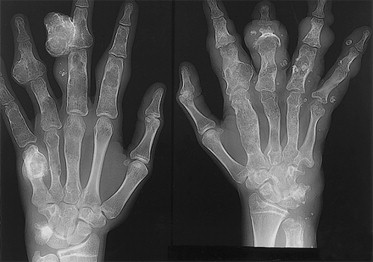Ollier disease or Enchondromatosis multiple, described by French surgeon Louis Ollier (1830 – 1900), is a rare bone disease affecting both men and women.
The prevalence of this disease is not accurately known. By extrapolation from a number of known patients in one French department, the figure of 300 to 500 sufferers in France has been put forward.
The disease is probably the result of a somatic mutation (mutation in a cell clone occurring during development, not affecting reproductive cells). However, the gene(s) involved have not been identified. A certain genetic heterogeneity (several possible mutations) has been suggested. Despite a few family cases (uncle-niece, siblings, etc.), this disease is not hereditary.
The disease is characterized by bone damage, and is defined by the coexistence of at least 3 asymmetrically located chondromas.
300
patients in France. Every year, 10 more people are reported.
A chondroma is a mass of excess cartilage tissue that escapes growth regulation and impairs normal bone development.

Characteristic of Ollier disease is its extreme clinical variability (size, age of onset and diagnosis of chondromas, number of chondromas, evolution, number of interventions required). Severity is related to the number of chondromas, the width of the chondroma in relation to the width of the metaphysis, and the age at which the first chondromas appear.
In most cases, the first signs of the disease appear in early childhood, although late diagnosis has been observed.
Not all chondromas implanted and identified in a person will systematically cause problems. Some remain inert and do not evolve. The mechanisms behind chondromas’ activity or stability are not yet known.
Chondromas often predominate on one side. To varying degrees and depending on the individual, they can lead to deformities, axial deviations and differences in bone length.
There is no bone fragility as such (unlike osteoporosis, osteogenesis imperfecta and fibrous dysplasia). There is local fragility, due to a loss of continuity in the bone structure. So if there is a shock and fracture, it will occur preferentially in the chondroma.
Some patients experience the sensitivity of certain chondromas (particularly on impact), while others experience more diffuse pain. These pains are due to the chondromas and their complications, notably the compressions they cause (nerves) and the resulting deformations and axis deviations. Pain inherent in statural imbalances is also mentioned.
When angiomas are associated with multiple enchondromatosis, we speak of Maffucci syndrome (or Kast syndrome or Maffucci-Kast syndrome, described by Italian pathologist Angelo Maffucci in 1881).
An angioma is a localized vascular lesion in the thickness of the skin or subcutaneous tissue (fat, muscle). In the case of Ollier-Maffucci disease, these abnormalities are often more frequent on the hands, appearing as vascularized, purplish clusters of flesh.
Angiomas can also cause pain.
The mutation(s) involved in Maffucci syndrome have also not been identified.
Patients have reported problems with fatigue. This may be partly due to the physical handicap associated with the chondromas (deviations, shortening), but the involvement of a (normal) psychological component should not be overlooked.
Associated tumors have been observed in Ollier disease and Maffucci syndrome. The medical literature cites several cases of benign ovarian tumors. Some members of the association have been affected.
